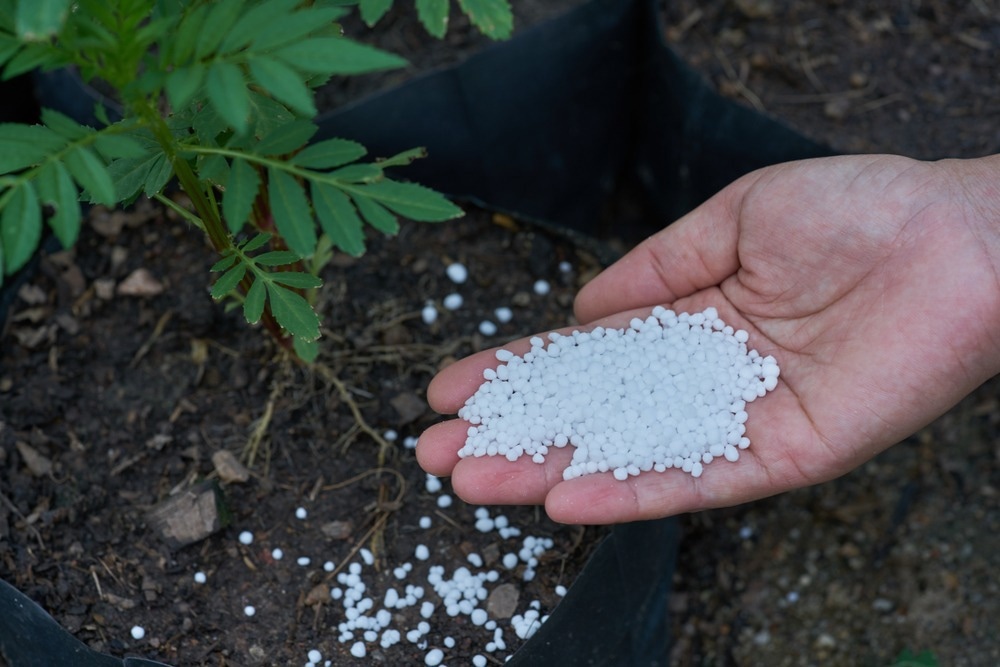Urea, a white crystalline solid containing 46% nitrogen, is extensively used in agriculture as an animal feed ingredient and fertilizer. However, urea has a very poor utilization efficiency since it is lost to the environment via processes such as leakage and volatilization.

Study: Eco-Friendly Urea Nanosack: Jute Grafted Silica Nanoring Woven Fertilizer to Control Urea Release and Enhance Crop Productivity. Image Credit: Criniger kolio/Shutterstock.com
A recent study published in the journal ACS Sustainable Chemistry & Engineering addresses this issue by creating a sustainable fertilizer with a jute grafted silica nanoring for regulating urea release and increasing the yield of rice plants.
Usage of Urea in Agriculture: Overview and Significance
Urea is the world's most extensively used solid nitrogen fertilizer. Urea is also present in nature since it is excreted in animal urine. Its high nitrogen concentration makes it easy to carry to agricultural fields to a variety of crops, including rice plants.
Rice plants are one of the most significant food crops, and they play a crucial part in ensuring global food security. Nitrogen (N) fertilizers, especially urea, are critical in increasing the output and quality of rice plants.
Urea is used in a variety of ways to supply nitrogen nutrition for the development of rice plants. It is usually combined with soil or applied straight to the soil's surface. It may also be dispersed in soil water, mixed with irrigation water, or sprayed over plant leaves. The leaves of rice plants readily absorb urea in foliar sprays.
Challenges Associated with Usage of Urea
Although global urea generation is over 200 million metric tons (MMT) per year, this is insufficient to fulfill agricultural requirements since the majority of urea produced is wasted due to leaching and evaporation.
As a result, a strong yet environmentally friendly coating is needed to limit these inefficiencies and transform demand into excess, utilizing current manufacturing capacity.
Various eco-friendly coating techniques have been proposed to combat the negative ecological impact of previously used petrochemical-based urea coatings. Polymer components produced from agricultural waste are frequently used in these environmentally friendly coatings to provide excellent urea-release control.
It has been widely reported that inorganic nanomaterials can provide many effective agricultural benefits. Inorganic oxides have been employed to regulate the production of urea bubbles, allowing for remarkable phase control.
Although such coatings have shown to be fairly beneficial in a variety of agricultural applications, their development is both expensive and time-consuming, and innovative, cost-effective coatings for urea-release control are desperately needed.
Porous Silicate Platforms for Controlled Urea Release
Porous structural platforms have lately attracted great scientific attention as nutritional repositories. In this regard, porous silicate has been employed in several agricultural settings for the controlled release of urea. In addition, the biocompatibility of the porous silicon guarantees its environmental stability.
The regulated nutrient release process necessitates a tightly packed silica coating, but an elevation in silica concentration can make the coating brittle. This is because the stiffness of the composite tissue exhibits a nonlinear response that increases with increasing composite concentration and subsequently drops.
A binder is required to arrange the silica compound into a coating for regulated nutrient release. Egg white protein can generate crack-free, mechanically robust, and strong coatings through a straightforward assembly process.
Highlights and Key Development of the Current study
In this study, the researchers fabricated a jute grafted silica nanoring (JSNR) coating with egg white as a binder for efficient urea release control. This coating made of jute grafted silica nanoring and egg white was tested on rice plants to determine its urea-controlling capability.
The unique fertilizer coating developed in this study is prepared in two phases. First, the silica is coated on the jute, and the composite is crushed into a jute grafted silica nanoring powder. This jute grafted silica nanoring powder is then disseminated in egg white and sprinkled over urea pellets.
The cellulose in jute grafted silica nanoring works as a clasp for the egg white to retain silica and build a hydrophobic buffer around the urea. Another significant benefit of egg white is its capacity to swiftly disintegrate into an irrevocable hydrophobic structure.
The as-prepared coating made of jute grafted silica nanoring is shown to be considerably resistant to leaking and evaporation losses, greatly increasing the yield of rice plants.
Reference
Sahu, B. K. et al. (2022). Eco-Friendly Urea Nanosack: Jute Grafted Silica Nanoring Woven Fertilizer to Control Urea Release and Enhance Crop Productivity. ACS Sustainable Chemistry & Engineering. Available at: https://pubs.acs.org/doi/10.1021/acssuschemeng.2c03372
Disclaimer: The views expressed here are those of the author expressed in their private capacity and do not necessarily represent the views of AZoM.com Limited T/A AZoNetwork the owner and operator of this website. This disclaimer forms part of the Terms and conditions of use of this website.